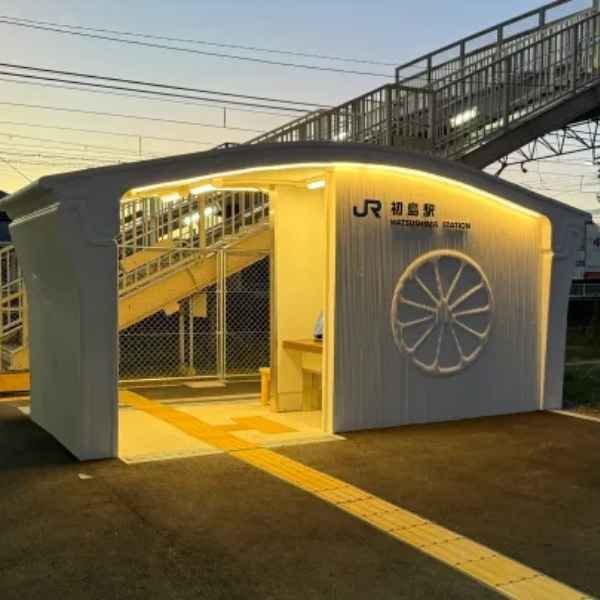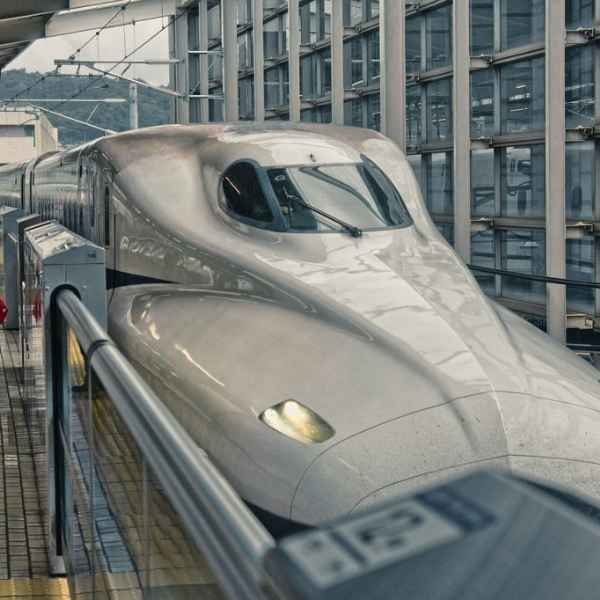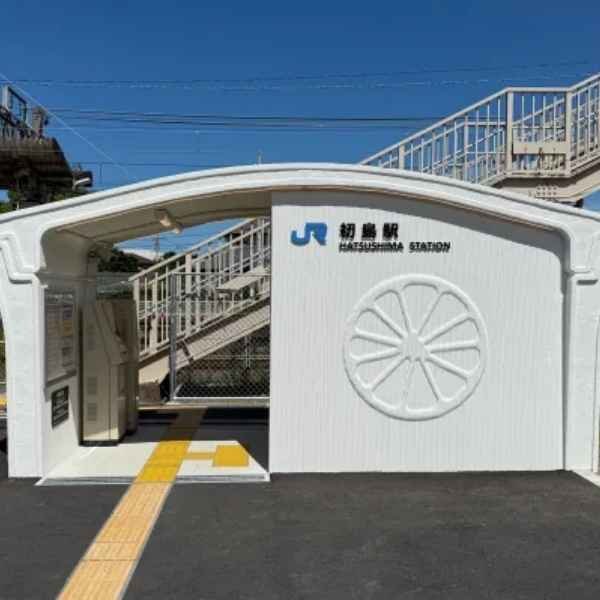Japan recently completed construction of the world’s first 3D-printed train station, Hatsushima Station, in just six hours, using prefabricated components. This groundbreaking project, carried out by West Japan Railway Company (JR West), marks a new era in infrastructure development where speed, sustainability, and innovation converge. By replacing an older wooden structure with a cutting-edge 3D-printed design, Japan has showcased how modern technology can transform traditional construction.
The process involved printing station components off-site and assembling them rapidly at the location. This not only minimized disruption to passengers but also proved to be a cost-effective and eco-friendly solution. The achievement underscores the potential of 3D printing to address labor shortages, rising construction costs, and the pressing need for durable rural infrastructure and Japan Created a 3D-Printed Train Station.
The Revolutionary Project: Hatsushima Station
West Japan Railway Company (JR West), in collaboration with Serendix and JR West Innovations, completed what they claim is the world’s first 3D-printed railway station in Japan. Located in the scenic Arida City of Wakayama Prefecture in the Kansai Region, this small but groundbreaking station represents the latest effort by West Japan Railway Company (JR West) to modernize rural infrastructure while preserving local charm.
The choice of Hatsushima Station for this pioneering project was strategic. While it is not immediately clear why the lesser-known Hatsushima Station was chosen, JR West said the project will provide them and other Japanese transit companies a chance to explore “sustainable building materials and cutting-edge technologies” for other regions in the future.
A technological first for Japan — and the world
Measuring just 10 square meters, the new single-story station was built using 3D-printing technology, a first for railway infrastructure anywhere in the world. The structure is made from reinforced concrete, with all components 3D-printed off-site by Osaka-based firm Serendix, known for its speedy, sustainable construction methods.
Once printed, the pieces were transported to the site and assembled in around six hours during a break in the train schedule — an astonishingly fast timeline compared to traditional builds. For passengers and local residents, this meant minimal disruption to services and a seamless upgrade to a more durable, weather-resistant station. The building also has earthquake resistance similar to that of reinforced concrete houses, JR West said.
The innovative project was spearheaded by West Japan Railway Company, which continues to experiment with new technologies for the future of transportation.

A design that celebrates local culture
While the construction method is thoroughly modern, the station’s design pays homage to the region’s culture and economy. The exterior features decorative reliefs of mandarin oranges and beltfish — two specialties of Arida City.
The building’s rounded, dome-like shape also recalls traditional architectural aesthetics while showcasing how futuristic technology can blend harmoniously with local identity.
If you’re planning a long trip across the country, you might wonder is the Japan Rail Pass worth it before making the purchase.
Solving big problems for small stations
Japan is known for its efficient and expansive rail network, but rural stations have faced increasing challenges in recent years. Declining populations and tight budgets have made it difficult to maintain aging infrastructure, leaving many stations in need of attention.
JR West sees 3D-printing as a smart, cost-effective solution to these challenges. Hatsushima Station is being used as a test case, and if it proves successful in the long term, similar upgrades could be rolled out across other small and mid-sized stations throughout Japan.
What this means for travelers
For visitors riding the rails across Japan, especially those exploring off-the-beaten-path destinations, this project marks a step toward more comfortable, modern, and sustainable travel experiences.
While the Hatsushima Station itself is small and serves a quiet region, it symbolizes a much larger shift in how Japan approaches infrastructure — keeping quality high while embracing cutting-edge solutions.
Thinking of exploring Wakayama?
With beautiful coastal scenery, historic temples, and now a piece of world-first technology, Arida City is a unique stop for the curious traveler. Discover the region with your Kansai Wide Area Pass.
For travelers who wish to explore different routes and regional connections, JR West also provides detailed information on tickets and passes to make journeys more convenient.

Why Japan Created a 3D-Printed Train Station
Japan’s railway system is among the most advanced in the world, handling millions of passengers daily. The need for innovation in station design comes from three major factors:
- Sustainability – Traditional construction methods consume vast amounts of resources. 3D-printing reduces waste and allows for eco-friendly materials.
- Speed – Unlike conventional construction, which may take months or years, 3D-printed structures can be built in a matter of hours.
- Flexibility – 3D-printing allows for modular, customizable designs that can be replicated or adapted for different locations.
By creating this station, Japan is not just modernizing its railway infrastructure but also paving the way for a global revolution in construction technology.
For travelers who want to plan ahead, our detailed guide on Japan travel budget will help you estimate costs for accommodation, food, and transport.
The Technology Behind Japan’s 3D-Printed Train Station
3D-printed construction relies on advanced robotic arms and large-scale printers that use a mixture of concrete and composite materials. Instead of laying bricks or steel manually, the printer extrudes material layer by layer, building strong, durable structures in record time.
- Material Used – A specially formulated, eco-friendly concrete mix was used for structural stability.
- Time Efficiency – Reports indicate that the core structure of the station was printed in just 6 hours, a feat that would normally take weeks.
- Design Innovation – The station integrates modern architectural aesthetics with passenger-friendly layouts, ensuring it is not only futuristic but also functional.
For those curious about technical documentation, many architects and students are searching for a “Japan created a 3D-printed train station PDF” to understand the detailed structural design. Such reports highlight the enormous potential of 3D-printing in infrastructure.
Read More-:
Meaning of Japan Created a 3D-Printed Train Station
When we talk about the phrase “Japan created a 3D-printed train station meaning”, it goes beyond just a construction project. It symbolizes:
- A technological leap in railway infrastructure.
- A commitment to sustainability and eco-conscious building.
- A demonstration of speed and efficiency in public projects.
- A potential model for developing nations looking to modernize transportation quickly and affordably.
In essence, Japan is proving that 3D-printing can move from small-scale housing projects to massive, passenger-centric public infrastructure.
Many young learners are exploring opportunities to study in Japan for Indian students, opening doors to education and cultural exchange.
The Global Significance of Japan’s 3D-Printed Railway Station
This station is not just a Japanese achievement but a global milestone. Other countries are now closely watching how 3D-printing can:
- Reduce construction costs in public projects.
- Minimize disruption in busy cities, as faster builds mean less downtime.
- Set new standards in modern railway design.
India, for example, has already experimented with 3D-printed houses and office buildings. Discussions about creating a 3D-printed railway station in India are now gaining momentum. Similarly, countries like China, the UAE, and the U.S. are investing heavily in 3D-printing infrastructure research.
Getting around efficiently is key, and our article on how to use Japan public transport explains trains, buses, and IC cards in detail.

Challenges and Future Prospects
While Japan’s achievement is groundbreaking, 3D-printed infrastructure still faces challenges:
- Regulatory Approvals – Many countries do not yet have building codes for 3D-printed structures.
- Material Limitations – While concrete mixes are evolving, durability tests for extreme weather and seismic conditions are ongoing.
- Cost of Technology – Large-scale 3D-printers are still expensive, though costs are falling with wider adoption.
In the future, we may see entire railway networks adopting 3D-printing for not just stations but also pedestrian bridges, waiting lounges, and even railway housing colonies.
If you’re new to the country, check out our complete guide for first-time visitors to Japan to avoid common mistakes and enjoy a smoother trip.
Frequently Asked Questions (FAQ)
1.Which country has built the world’s first 3D-printed railway station?
Japan has built the world’s first 3D-printed railway station at Hatsushima Station in Wakayama Prefecture. The project was completed by West Japan Railway Company (JR West) in collaboration with Serendix and JR West Innovations, marking a historic milestone in infrastructure development and demonstrating Japan’s leadership in construction technology innovation.
2.How did Japan build a 3D-printed train station in 6 hours?
Japan achieved this remarkable feat through meticulous pre-planning and modular construction techniques. The station components were 3D-printed off-site using reinforced concrete materials, then transported to the location as four separate mortar pieces. The assembly was strategically scheduled between the last train of the night and the first train of the following morning, allowing uninterrupted railway service. The modular design enabled rapid assembly with minimal on-site work, demonstrating the efficiency of advanced manufacturing combined with precise logistics coordination.
3.What is a 3D-printed railway station?
A 3D-printed railway station is a transportation infrastructure building constructed using additive manufacturing technology, where reinforced concrete or other suitable materials are printed layer by layer to create structural components. Unlike traditional construction that involves cutting, assembling, and welding materials, 3D printing builds structures by depositing material precisely where needed. This technology allows for complex geometries, reduced material waste, faster construction times, and potentially lower costs while maintaining structural integrity and safety standards required for public infrastructure.
4.How did Japan build a train station in 6 hours?
Japan accomplished this through innovative 3D printing technology combined with modular construction principles. The process involved printing reinforced concrete components off-site in controlled conditions, ensuring quality and precision. These pre-fabricated modules were then transported to Hatsushima Station and assembled during a carefully planned six-hour window between train services. The success required extensive coordination between engineering teams, precise timing, and advanced preparation to ensure all components fit perfectly together without disrupting railway operations.
5.Which was the first 3D-printed railway station in India?
Currently, India has not built a 3D-printed railway station. Japan’s Hatsushima Station remains the world’s first and only 3D-printed railway station as of 2025. However, India has been exploring 3D printing technology for various construction projects and infrastructure development. The success of Japan’s project may inspire similar initiatives in India’s extensive railway network, potentially leading to pilot projects that could adapt this technology to Indian conditions and requirements.
6.Which country made a railway station in 9 hours?
While Japan built the world’s first 3D-printed railway station in 6 hours, specific information about a railway station built in exactly 9 hours is not readily available in current records. However, several countries have achieved rapid construction projects using prefabrication and modular construction techniques. China has been notable for extremely fast infrastructure construction, including rapid station building using prefabricated components, though specific timing may vary by project complexity and size.
7.Which is the world’s oldest railway station?
The world’s oldest railway station is generally considered to be Liverpool Road Station in Manchester, England, built in 1830 as part of the Liverpool and Manchester Railway. This station represents the beginning of passenger railway transportation and marked the start of the railway age. The station building still exists today as part of the Museum of Science and Industry in Manchester, serving as a historical monument to the birth of modern railway transportation.
8.Why does Indian railway use a 24-hour clock?
Indian Railways uses the 24-hour clock system (also known as military time) to eliminate confusion between AM and PM times, which is crucial for railway operations that run continuously throughout the day and night. This system prevents scheduling errors, miscommunication between railway staff, and potential safety issues that could arise from time confusion. The 24-hour format is standard in transportation industries worldwide because it provides unambiguous time reference, essential for maintaining precise schedules, coordinating train movements, and ensuring passenger safety across the extensive Indian railway network.
10.Which country did not have a railway station?
Several small island nations and landlocked countries historically did not have railway stations due to geographical constraints, small population sizes, or economic factors. Countries like Maldives, with its scattered island geography, traditionally relied on boats and aircraft rather than railways. Some small Pacific island nations and certain African countries had limited or no railway infrastructure due to terrain challenges or economic priorities focused on other transportation modes like roads and airports.
Conclusion
The fact that Japan created a 3D-printed train station is more than just headline news—it is a transformative moment in infrastructure history. This project illustrates how technology, sustainability, and efficiency can come together to redefine public transport systems.
As the world looks toward eco-friendly and faster construction solutions, Japan’s achievement serves as a blueprint for the future of global railway development. The success of this pioneering project signals that tomorrow’s cities may very well be built with 3D-printers—faster, stronger, and smarter.



 At My Japan Advisor, whether you’re planning a trip, preparing for the JLPT, exploring Japanese culture, or navigating visa processes, we provide expert insights, practical guides, and up-to-date information to make your journey smooth and enjoyable.
At My Japan Advisor, whether you’re planning a trip, preparing for the JLPT, exploring Japanese culture, or navigating visa processes, we provide expert insights, practical guides, and up-to-date information to make your journey smooth and enjoyable.